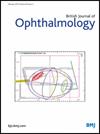在一项多中心的印度研究中,学童眼镜依从性的患病率和相关性
IF 3.5
2区 医学
Q1 OPHTHALMOLOGY
引用次数: 0
摘要
背景/目的评估喀拉拉邦、马哈拉施特拉邦、中央邦、泰米尔纳德邦和西孟加拉邦城市和农村地区公立和私立学校的儿童佩戴眼镜的情况。方法邀请某地区6家合作医院之一所服务的所有学校参与调查。使用袖珍视力筛检器对5至18岁儿童进行视力筛检。无法单眼阅读0.2 logMar字母(Snellen equivalent约6/9)的儿童,能够通过+1.50 DS透镜阅读,已经戴眼镜或有眼部疾病或异常的儿童由视力专业人员现场检查。根据特定年龄的指导方针和主观改进提供眼镜。依从性评估通过直接观察在一个未通知的随访访问。结果在2145所学校的31991名儿童中,有29667名(92.7%)在随访中位数为5.6个月,而不是计划的3个月。其中贴壁19 679例(66.3%)。视力较差、年龄较小、就读于农村或政府支持的学校、人类发展指数较低地区或首次佩戴眼镜的儿童的依从性较高(均p<0.001),但性别差异不显著(p=0.414)。散光患儿的依从性高于近视患儿(p<0.001),远视患儿的依从性高于近视患儿(p=0.455),后两种情况的依从性相似(p=0.903),随随访时间延长而降低(p<0.05)。这项涵盖广泛地理区域和各种学校的大型研究表明,最需要免费服务的儿童中戴眼镜的比例较高:那些生活在农村、贫困地区、上公立学校和以前没有眼镜的儿童。如有合理要求,可提供资料。不适用。本文章由计算机程序翻译,如有差异,请以英文原文为准。
Prevalence and associations of spectacle adherence among school children in a multicentre Indian study
Background/aims To assess adherence to spectacle wear among children attending public and private schools in urban and rural locations in Kerala, Maharashtra, Madhya Pradesh, Tamil Nadu and West Bengal. Methods All schools within a district served by one of six partner hospitals were invited to participate. Vision screening occurred in children aged 5 to 18 years using a pocket vision screener. Children unable to read 0.2 logMar letters (Snellen equivalent approximately 6/9) monocularly, able to read them through a +1.50 DS lens, already wearing spectacles or with ocular complaints or abnormalities were examined on-site by a vision professional. Glasses were provided according to age-specific guidelines and subjective improvement. Adherence was assessed by direct observation at an unannounced follow-up visit. Results Among 31 991 children prescribed glasses at 2145 schools, 29 667 (92.7%) were available at follow-up median of 5.6 months instead of a planned 3-month follow-up. Of these, 19 679 (66.3%) were adherent. Adherence was higher in children with poorer presenting vision, younger age, attending rural or government-supported schools, in areas with lower human development index or wearing spectacles for the first time (all p<0.001) but did not differ by sex (p=0.414). Adherence was higher in children with astigmatism than myopia (p<0.001) but not hyperopia (p=0.455), was similar in the latter two conditions (p=0.903) and decreased with longer follow-up intervals (p<0.05). Conclusion This large study covering a wide geographic area and variety of schools reveals higher wear among children in greatest need of free service: those living in rural, poorer areas, attending government schools and not previously owning glasses. Data are available upon reasonable request. Not Applicable.
求助全文
通过发布文献求助,成功后即可免费获取论文全文。
去求助
来源期刊
CiteScore
10.30
自引率
2.40%
发文量
213
审稿时长
3-6 weeks
期刊介绍:
The British Journal of Ophthalmology (BJO) is an international peer-reviewed journal for ophthalmologists and visual science specialists. BJO publishes clinical investigations, clinical observations, and clinically relevant laboratory investigations related to ophthalmology. It also provides major reviews and also publishes manuscripts covering regional issues in a global context.

 求助内容:
求助内容: 应助结果提醒方式:
应助结果提醒方式:


